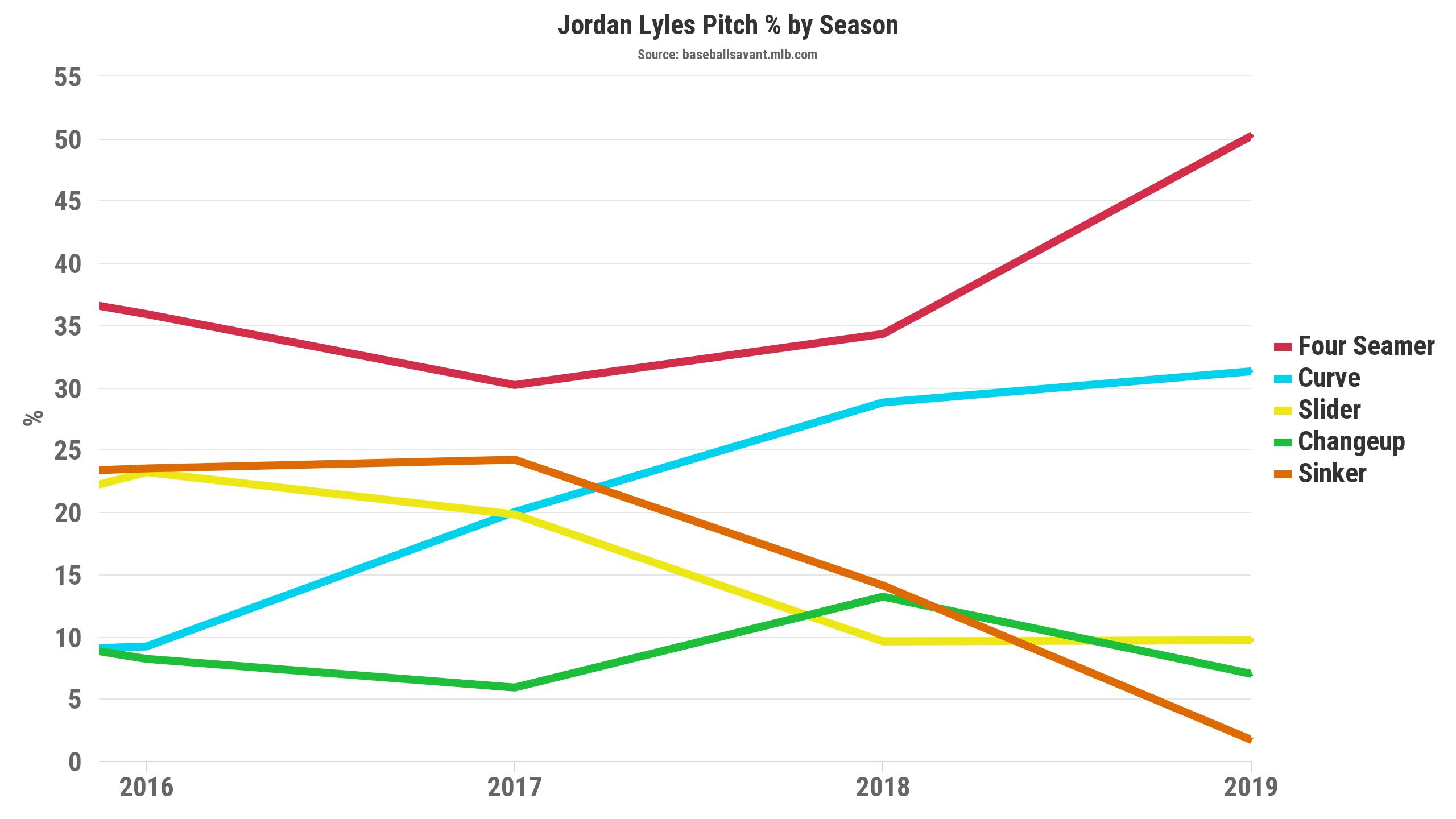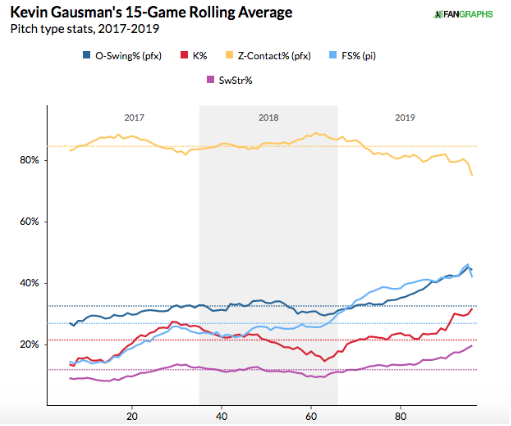In recent years, we have seen the best relievers in the league spurned from mediocre starters. Josh Hader did not make a relief appearance in 2016 or 2017 while in the Brewer’s farm system. Seth Lugo started the World Baseball Classic Championship Game for Puerto Rico in 2017. Wade Davis started 24 games for the Royals in 2013. Drew Pomeranz was starting games as recently as July and is now one of the highest-paid relievers in baseball!
There is nothing specific that ties these and so many other transformed starters together: some only really had a pitch or two they could rely on, some needed a velocity bump to reach their next level, some just needed to recreate their mental edge. However, a common thread among those who have found success down this path in identifying exactly what works best for them and relying on it more than before. Here, I will dive into three active ’starters’ who would give their teams far better value if they were to become relievers.
Simply speaking, there is little reason to believe Wacha can be an effective starting pitcher at this juncture in his career. Once a prominent front-line starter, he has been reduced to a mere scrap-heap signing in just a few short seasons. His incentive-laden contract from the Mets does not instill much hope that he can return to glory. An unsightly 18.5 K% last season was a career-low and catalyzed a horrific 5.61 FIP, yet Wacha remains adamant that he is still a starting pitcher. Well, that is a tall task when you only have one pitch that can get anybody out.
| Pitch | SwSt% | xwOBAcon | K-BB% |
|---|---|---|---|
| Fastball | 5.1 | .421 | 3.4 |
| Changeup | 21.9 | .363 | 29.3 |
| Cutter | 7.9 | .386 | -2.5 |
| Curveball | 5.4 | .440 | 5.0 |
His fastball’s effectiveness has completely evaporated over the past three seasons as its velocity continues to decline. It generates next to no swinging strikes, is hit very well, and lacks any sort of desirable quality whatsoever.
| Year | Velocity (mph) | Percentile | RPMs | Percentile | SwSt% | xwOBAcon | K-BB% |
|---|---|---|---|---|---|---|---|
| 2017 | 95.1 | 70th | 2159 | 34th | 7.3 | .374 | 8.1 |
| 2018 | 93.6 | 43rd | 2071 | 19th | 6.5 | .436 | 4.9 |
| 2019 | 93.0 | 38th | 2032 | 9th | 5.1 | .421 | 3.4 |
Yet, for reasons unbeknownst to me, he threw it more in 2019 than 2018, jumping from 42% of the time to 49%! It is difficult to understand the rationale behind featuring this pitch that has so obviously dropped off while his changeup remains wicked.
Michael Wacha, Disgusting 85mph Changeup. 😷 pic.twitter.com/IsVNhxgwt1
— Rob Friedman (@PitchingNinja) April 17, 2019
A shift to the bullpen would allow Wacha to refine his repertoire with a newfound focus on the pitch. For comparison’s sake, five RPs threw off-speed, non-breaking pitches (changeup or splitter) more than 50% of the time last season: Luis Avilan, Oliver Drake, Yoshihisa Hirano, Hector Neris, and Tommy Kahnle. Not all of them have a devastating fastball, most of them don’t. Yet, each was still effective overall on the backs of their primary offering.
| Pitcher | CH/FS Usage | Velocity | SwSt% | xwOBAcon | K-BB% | FB Usage | Velocity | Velocity Difference | FIP (Overall) |
|---|---|---|---|---|---|---|---|---|---|
| Avilan (CH) | 58.3 | 82.5 | 16.4 | .366 | 18.6 | 29.5 | 90.4 | 7.9 | 4.96 |
| Drake (FS) | 59.5 | 84.0 | 18.2 | .325 | 28.9 | 40.5 | 93.5 | 9.5 | 3.87 |
| Hirano (FS) | 51.7 | 83.9 | 21.0 | .295 | 27.8 | 48.0 | 91.1 | 7.2 | 4.04 |
| Neris (FS) | 65.4 | 87.0 | 21.5 | .311 | 24.9 | 25.8 | 94.4 | 7.4 | 3.83 |
| Kahnle (CH) | 51.9 | 90.0 | 26.9 | .336 | 43.5 | 44.2 | 96.4 | 6.4 | 3.33 |
| Wacha (CH) | 23.8 | 85.5 | 21.9 | 0.363 | 29.3 | 49.5 | 93.0 | 7.5 | 5.61 |
Wacha’s changeup compares favorably to those above without considering the expected velocity gains for his fastball if he were to throw it fewer times per game in relief. Also, notice that Neris and Avilan are the only pitchers on this list (besides Wacha) who utilize a third pitch with any volume. The Mets will likely rely on Wacha to man their 5th rotation spot in the wake of Noah Syndergaard’s injury, but there exists an avenue for Wacha to be an upper-echelon reliever immediately and it would behoove them to explore that option.
If anyone out there wants to read more on Wacha specifically, I dove deeper for an article at Metsmerized that gave me the inspiration for the rest of this blog.
Lyles was more than fine as a starter for the Brewers last season, so his inclusion here might seem a bit puzzling. He went 7-1 with a 2.45 ERA and 23.5 K% in 11 starts after being traded from Pittsburgh to Milwaukee on July 30th. That’s pretty, pretty, pretty good. The Brewers have a knack for squeezing the absolute most value out of their arms and they did so with Lyles.
Although, his peripherals indicate he was the beneficiary of some very good fortune. Lyles stranded 87.8% of baserunners and opposing hitters had a .225 BABIP against him. Neither of these stats is particularly predictive, but both being so far from his career and league averages, in addition to him leaving Miluawkee for Arlington, suggest the potential for regression.
Lyles also struggled tremendously when facing the opposing lineup for the third time. Aware of this, the Brewers limited such exposure. Facing only 40 batters for the third time, he allowed seven runs while walking the same amount of batters he struck out (7:7). This was a stark change from his 17.2 K-BB% and 3.71 FIP in 50 innings combined between his 1st and 2nd times through the order. Luckily, this problem would never come up if Lyles was moved to the bullpen.
Granted, Lyles already has 130 career relief innings under his belt and the results have not been convincing. His career FIP is lower as a starter, but there are few similarities between Lyles now and Lyles when he began to pitch in relief. The Rockies transitioned Lyles to the bullpen in June of 2016 and it seemed he was still posing as a starter in the sense that he was actively mixing five pitches. I applaud his proclivity to do so while none were particularly effective.
| Pitch | Usage (%) | SwSt% | xwOBAcon | K-BB% |
|---|---|---|---|---|
| Fastball | 30.2 | 6.6 | .323 | 0.0 |
| Slider | 26.1 | 7.6 | .342 | 6.7 |
| Sinker | 25.2 | 7.8 | .289 | 2.4 |
| Curveball | 9.7 | 8.5 | .257 | 6.7 |
| Changeup | 8.8 | 15.1 | .446 | 15.4 |
Lyles tinkered with his pitch-mix every year since. He began to see success in 2018, earning his best FIP as a reliever by nearly half a run (4.09). It was also the first season where his K% climbed above 20%. The biggest change: an increased willingness to throw his curveball.

League-wide, pitchers have displayed a similar willingness over the past handful of seasons. A well-documented philosophical shift emphasized not just throwing more breaking balls, but also throwing them in more varied counts. Lyles followed suit and steadily increased his CB% when he is either behind in the count or on the first pitch of at-bats.
| Year | Usage (%) |
|---|---|
| 2016 | 3.2 |
| 2017 | 5.7 |
| 2018 | 10.4 |
| 2019 | 12.1 |
That’s a nearly 400% jump in just four years! Also, it is noteworthy that the season in which his skills took the greatest leap was the same season where this type of curveball use increased the most (2018). Last season with the Brewers, Lyles’ curve was a certifiable weapon earning a 31.9 K-BB%, Lyles’ highest for an individual pitch by more than 15% in a year where its use was the most varied to date. There is no question it should be thrown as much as possible.
Along with the curve, Lyles’ four-seamer has routinely played up in relief. In 95 relief appearances from 2016-18, it averaged 94.4 mph. Compared to the 93.0 it averaged last year, that’s a serious jump. These two pitches work well off one another and it’s easy to envision a Pomeranz-like reliever developing out of Lyles.
The Rangers paid him $8 million, presumably to be a starter based on their organizational depth, but their bullpen is far from a strength. Last season’s successes may very well have been fool’s gold and Lyles could realize far more value as a two-pitch reliever.
You can set your watch to Gausman showing up on breakout/sleeper lists every season. The former 4th overall pick of the MLB draft was undoubtedly signed by the Giants to be a member of their rotation: $10 million annually and little to no competition assures this. Based on the opportunity, pedigree, and stuff, why not take another shot on Gausman?
Last offseason was no different than this one. A move from Baltimore to Atlanta catalyzed a strong second half and Gausman parlayed this into a guaranteed rotation spot heading into 2019. Expectations were set sky-high and we all wrote our articles talking about Gausman turning the corner and realizing his lofty potential. His failure was his most spectacular to date as the Braves put the right-hander on waivers in August after compiling a 6.19 ERA in 15 starts: rock-bottom.
The Reds took a flier on Gausman and he turned a new page during August and September in a bullpen role.
| Role | IP | SwSt% | xwOBAcon | K-BB% |
|---|---|---|---|---|
| SP | 82 | 13.3 | .405 | 16.6 |
| RP | 20 1/3 | 22.3 | .386 | 26.8 |
A 20 inning sample cannot prove anything, but adjustments he made before last season indicate he may be better suited for a relief role after all. He almost completely gave up on his slider and became a two-pitch pitcher focusing on his fastball/splitter combo. Why not, considering how these two play off one another?
Kevin Gausman, 96mph Fastball and 85mph Splitter, Overlay. pic.twitter.com/fHEHGAxluX
— Rob Friedman (@PitchingNinja) April 6, 2019
He threw more splitters in 2019 than ever before and saw its skills improve in unison with the uptick in usage.

The thought of Gausman jogging in from the pen equipped with a 98 mph fastball and devastating splitter gives me a little chill. If the Giants came out and (albeit, randomly) announced him as their closer there should be no hesitation in drafting him top-10 at the position. That’s how high his potential is in relief.
Would there be any very serious issues with Wacha, Lyles, Gausman gutting out 20-25 starts this season? Certainly not. Would they have a greater impact on their team’s place in the standings and very possibly the next stage of their careers if they followed in the footsteps of Lugo, Davis, or Pomeranz? That remains to be seen.
All pitch statistics courtesy of Alex Chamberlain’s Pitch Leaderboard
Featured Image by Alyssa Buckner – alyssabuckter.com | Michael Wacha posed photo by Jimmy Simmons/Icon Sportswire

